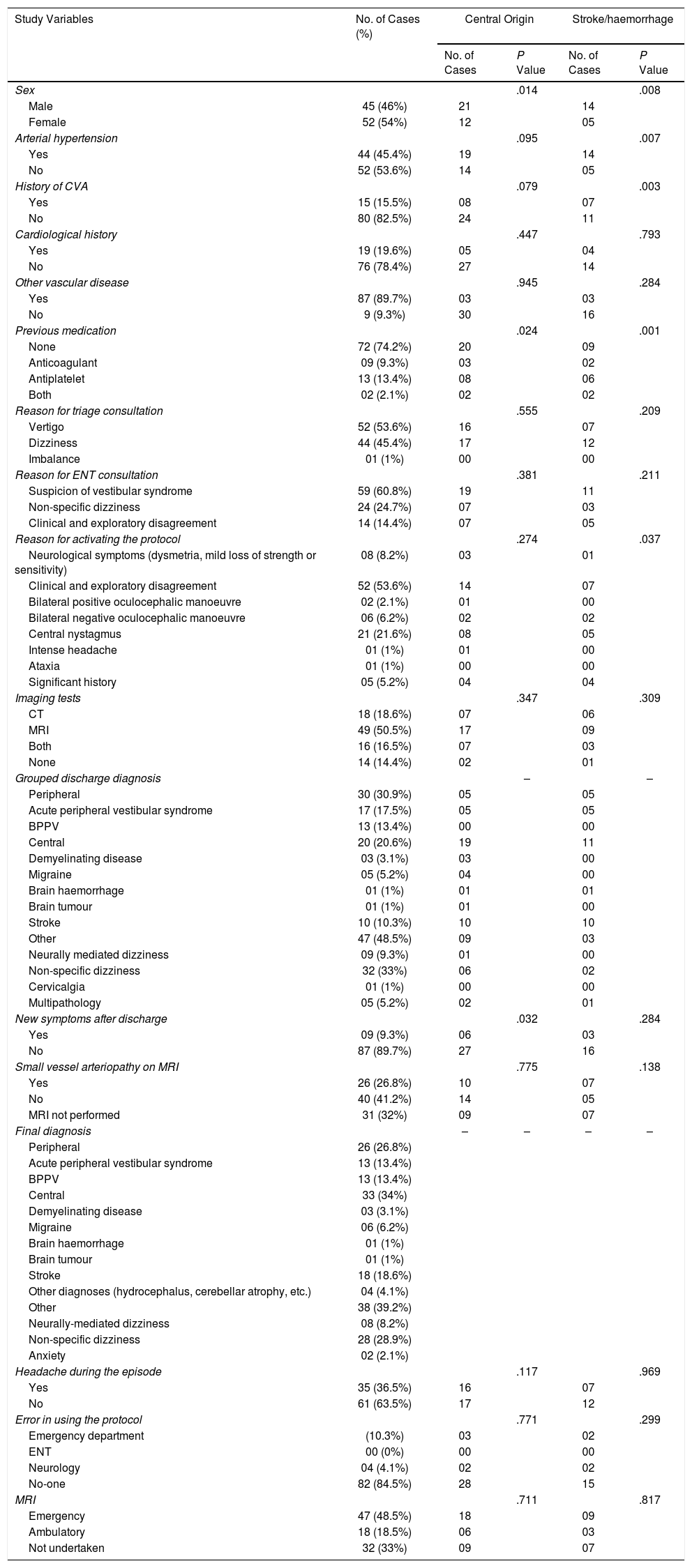Differential diagnosis of vertigo is a diagnostic challenge in the emergency setting. In our centre we have created a vertigo protocol to distinguish the different pathologies and their management in the emergency department. Our goal is to determine the efficacy of our hospital protocol in the diagnostic and therapeutic approach to acute vestibular syndrome.
Patients and methodsIt is a retrospective descriptive observational study on patients with a diagnosis of acute vestibular syndrome in the emergency department using our unclear origin vertigo protocol. All patients underwent an examination that included the HINTS protocol and had a minimum follow-up of 6 months. The results of the clinical assessments by the specialists were compared, as well as the physical examination with the different final diagnoses classified as peripheral, central and other-origin.
ResultsWe obtained 97 patients, with a mean age of 61.46 years. The final diagnoses were 26 patients for the peripheral group (26.8%), 38 for the other-origin group (39.2%) and 33 for the central group (34%). Stroke was found in 18 of the latter group, clinical-exploratory disagreement being the most frequent reason for activation of the protocol.
ConclusionsOur protocol has proven to be a useful tool to differentiate a possible acute vestibular syndrome of central origin from a peripheral one, avoiding unnecessary imaging tests. The most frequent cause of activation of the protocol was clinical-exploratory disagreement seen by the ENT doctor.
El diagnóstico diferencial de vértigo supone un reto diagnóstico en el ámbito de urgencias. En nuestro centro hemos creado un protocolo de vértigo para ayudar a distinguir las diferentes patologías y su manejo en urgencias. Nuestro objetivo es determinar la eficacia de nuestro protocolo hospitalario en la actitud diagnóstica y terapéutica ante un síndrome vestibular agudo.
Pacientes y métodosEstudio observacional, descriptivo, retrospectivo, sobre pacientes ingresados con diagnóstico de síndrome vestibular agudo en urgencias mediante nuestro protocolo de vértigo de origen dudoso. A todos los pacientes se les realizó una exploración que incluyera el protocolo HINTS y tuvieron un seguimiento mínimo durante seis meses. Se compararon los resultados del estudio de impresiones clínicas por parte de los especialistas, así como la exploración física con los diferentes diagnósticos finales clasificados en periférico, central y otro origen.
ResultadosObtuvimos 97 pacientes con una edad media de 61,46 años. Los diagnósticos finales fueron de 26 pacientes en el grupo periférico (26,8%), 38 en otro origen (39,2%) y 33 en central (34%). En este último se objetivaron accidentes cerebrovasculares en 18 de ellos, siendo el motivo más frecuente de activación del protocolo una discordancia clínico-exploratoria.
ConclusionesNuestro protocolo ha demostrado ser una herramienta útil para poder diferenciar un posible síndrome vestibular agudo de origen central de uno periférico, evitando la realización de pruebas de imagen de manera innecesaria. La causa más frecuente de activación del protocolo fue la discordancia clínico-exploratoria vista por el otorrino de guardia.











